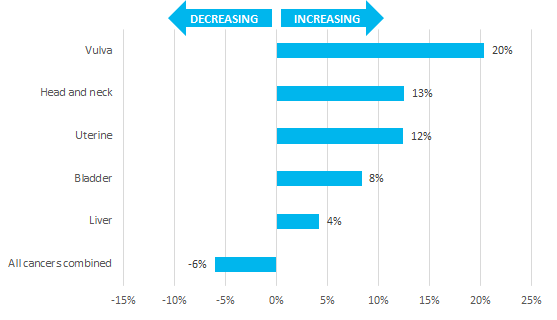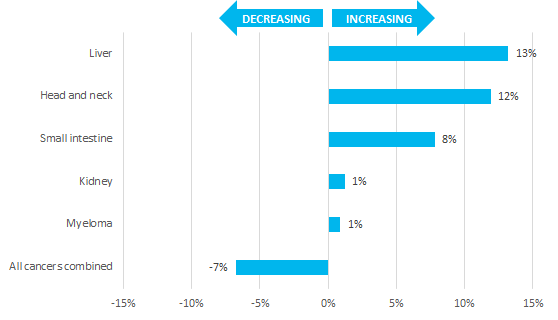Mortality rates are projected to fall for most types of cancer in the UK between 2023-2025 and 2038-2040.[1] Among cancer types where rates are projected to fall, the size of the overall decrease between 2023-2025 and 2038-2040 ranges from less than 1% (kidney cancer) to 29% (mesothelioma).
For a smaller number of cancer types, mortality rates are projected to rise in the UK between 2023-2025 and 2038-2040. Among cancer types where rates are projected to rise, the size of the overall increase between 2023-2025 and 2038-2040 ranges from 1% (small intestinal cancer) to 45% (anal cancer).
For almost all cancer types – even those where age-standardised mortality rates are projected to fall – absolute numbers of deaths are projected to rise because of population growth and ageing.
These projections reflect past trends in cancer mortality. They do not model the possible impact of current or future changes which may increase or decrease cancer incidence or mortality. For HPV-related cancers (cervical, pharyngeal, anal, vulval, penile, vaginal, and oral cavity), HPV vaccination is expected to substantially decrease future incidence and therefore probably also mortality.[2,3]
Selected Cancers, European Age-Standardised Mortality Rates and Average Annual Number of Deaths, Females, UK, 2023-2025 and 2038-2040
| |
Age-standardised Rate (per 100,000 females) |
Average Annual Deaths |
| |
2023-2025 (Projected) |
2038-2040 (Projected) |
% Change |
2023-2025 (Projected) |
2038-2040 (Projected) |
% Change |
| Lung |
48 |
45 |
-6 |
18124 |
20859 |
15 |
| Breast |
29 |
25 |
-13 |
10752 |
11385 |
6 |
| Bowel |
19 |
18 |
-8 |
7536 |
8764 |
16 |
| Pancreas |
13 |
13 |
-5 |
5027 |
5940 |
18 |
| Cancer of unknown primary |
12 |
10 |
-14 |
4659 |
5077 |
9 |
| Ovary |
11 |
9 |
-15 |
4005 |
4091 |
2 |
| Uterus |
8 |
9 |
12 |
3047 |
4248 |
39 |
| Liver |
7 |
7 |
4 |
2600 |
3392 |
30 |
| Brain, other CNS and intracranial |
7 |
7 |
-1 |
2472 |
2849 |
15 |
| Oesophagus |
7 |
6 |
-10 |
2523 |
2864 |
14 |
| Non-Hodgkin lymphoma |
6 |
5 |
-13 |
2323 |
2579 |
11 |
| Leukaemia |
5 |
4 |
-14 |
1923 |
2083 |
8 |
| Bladder |
5 |
5 |
8 |
1914 |
2682 |
40 |
| Kidney |
5 |
5 |
-4 |
1842 |
2195 |
19 |
| Myeloma |
4 |
4 |
-9 |
1516 |
1764 |
16 |
| Head and neck |
4 |
4 |
13 |
1440 |
1946 |
35 |
| Stomach |
4 |
3 |
-14 |
1399 |
1522 |
9 |
| Melanoma skin |
3 |
2 |
-13 |
1027 |
1117 |
9 |
| Vulva |
1 |
2 |
20 |
560 |
865 |
54 |
| Gallbladder |
1 |
1 |
0 |
495 |
617 |
25 |
Download the data table (xlsx)
Selected Cancers, European Age-Standardised Mortality Rates and Average Annual Number of Deaths, Males, UK, 2023-2025 and 2038-2040
| |
Age-standardised Rate (per 100,000 males) |
|
|
Average Annual Deaths |
|
|
| |
2023-2025 (Projected) |
2038-2040 (Projected) |
% Change |
2023-2025 (Projected) |
2038-2040 (Projected) |
% Change |
| Lung |
59 |
52 |
-12 |
18699 |
20635 |
10 |
| Prostate |
44 |
42 |
-5 |
13249 |
17545 |
32 |
| Bowel |
29 |
26 |
-11 |
9123 |
10359 |
14 |
| Oesophagus |
18 |
16 |
-11 |
5866 |
6466 |
10 |
| Pancreas |
17 |
17 |
-3 |
5497 |
6648 |
21 |
| Cancer of unknown primary |
14 |
12 |
-12 |
4363 |
4932 |
13 |
| Liver |
14 |
15 |
13 |
4322 |
6067 |
40 |
| Bladder |
14 |
12 |
-11 |
4112 |
5044 |
23 |
| Head and neck |
11 |
13 |
12 |
3591 |
4794 |
34 |
| Kidney |
11 |
11 |
1 |
3391 |
4305 |
27 |
| Brain, other CNS and intracranial |
10 |
10 |
-1 |
3237 |
3714 |
15 |
| Non-Hodgkin lymphoma |
10 |
9 |
-11 |
3018 |
3444 |
14 |
| Leukaemia |
9 |
8 |
-15 |
2914 |
3247 |
11 |
| Stomach |
8 |
7 |
-14 |
2571 |
2842 |
11 |
| Mesothelioma |
7 |
5 |
-32 |
2183 |
1939 |
-11 |
| Myeloma |
7 |
7 |
1 |
2068 |
2709 |
31 |
| Melanoma skin |
5 |
4 |
-12 |
1527 |
1678 |
10 |
| Non-melanoma skin |
1 |
1 |
-9 |
362 |
468 |
29 |
| Small intestine |
1 |
1 |
8 |
360 |
489 |
36 |
| Thyroid |
1 |
1 |
0 |
193 |
242 |
25 |
Download the data table (xlsx)
Vulval cancer has the fastest-increasing projected mortality rate in females, rising by more than 20% between 2023-2025 and 2038-2040. Liver cancer has the fastest-increasing projected mortality rate in males, rising by more than 13% between 2023-2025 and 2038-2040.
The Five Cancers with the Highest Projected Percentage Change in European Age-Standardised Mortality Rates, Females, UK, 2023-2025 to 2038-2040
Download this data (xlsx)
The Five Cancers with the Highest Projected Percentage Change in European Age-Standardised Mortality Rates, Males, UK, 2023-2025 to 2038-2040
Download this data (xlsx)












